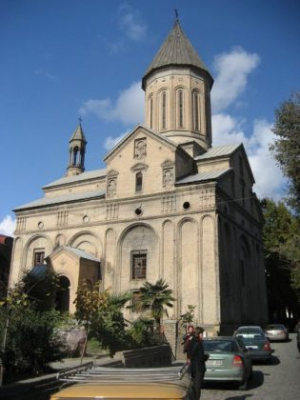ANALYTICS
09.11.19 11:35

St Nikolaos the Wondermaker Church in Tbilisi (Surb Nshan)
In Chveni Saunje (No 1, 2011), I published a paper “Armenians Unconditionally Demand Handing over St Nikolaos the Wondermaker Church in Tbilisi (Surb Nshan) to Them.” Based on the scholarly analyses of historical sources, I demonstrated that the church was built over an old Georgian cult monument. This standpoint is not shared by S. Karapetyan. It should be noted that, according to the Armenian scholar’s statement, St Nikolaos the Wondermaker Church (Surb Nshan) is Armenian; however, this is just a statement as far as “the new information,” by means of which he tries to prove his approach, does not attest that the church is Armenian; rather, it once again highlights the fact that Armenians got hold of it in the 17th c. If we consider that the date of its construction is unknown, the S. Karapetyan seems to start his investigations from the end. Initially he was to establish the date of its construction and then he would ascertain that it was Armenian. He failed to do it. As for “the new information,” detected by him, do not prove that St Nikolaos the Wondermaker Church (Surb Nshan) in Tbilisi is Armenian, but rather attests that, in the 17th c., Armenians had already misappropriated the church; it was known before. Unfortunately, so far we could not establish when and how they misappropriated it.
If S. Karapetyan wanted to initially prove that the church was Armenian, and this desire is obvious in his work, he was to present a reliable source which would at least hint to the date of its construction. If he believes that St Nikolaos the Wondermaker Church was built in the 17th c, then the aforementioned archival materials will be useless for him, as far as they inform about an Armenian monk who copied a manuscript in this church in 1624. Besides, another document is a memorandum about a gift and not a date of construction of the church. According to these Armenian documents, only one thing becomes clear: St Nikolaos the Wondermaker Church of Tbilisi was Armenian-Gregorian already in the 17th c.
S. Karapetyan offers “new inscriptions,” detected by him, telling about the restoration of the church.
Inscription 1: “111 (1662) …daughter-in-law, Gaspar, Bero’s mother-in-law, Karayahat (builder) Navasard of Arich, this church was built with his hand."
S. Karapetyan’s interpretation is the following: the epigraphic inscription helps establish the date of the following restoration (1662) and the name of its architect – Navasard. He has seen the khachkar with the inscription in the southern apse and infers: “… in all probability, the construction inscription of the church was moved to the southern apse after its erection for the sake of its preservation.”[1] It is interesting on what basis he inferred that the construction inscription was taken from the old church to the southern apse of the new one. He has got no document to attest it. However, he needs it to state that this 17th century inscription is “a fountainhead” attesting that, a century before the beginning of construction St Nikolaos (Surb Nshan) (he sometimes writes “construction” and sometimes “restoration;”however, there is a great semantic difference between them), there actually was Surb Nshan Church which was “substantial” restored “architect Navasard.”
I believe that it is a very biased. According to the inscription, there is nothing to show that there was an Armenian church, constructed a century ago, here before the 1662 restoration. There is nothing to attest that the old church had the same name as Surb Nshan…
Author Bondo Arveladze
To be continued
Read: 100
Write comment
(In their comments, readers should avoid expressing religious, racial and national discrimination, not use offensive and derogatory expressions, as well as appeals that are contrary to the law)
News feed
-
Parliament to hear Ministers of Interior and Economy on April 19
18:0018.04.24
-
Competition Agency: 23,983 concentrations of economic entities registered in Q1
17:2518.04.24
-
Georgian PM, EUMM Head review situation in Russian-occupied territories
16:4518.04.24
-
UK Ambassador on transparency bill: hindrances to civil society’s functioning “concerning”
16:1018.04.24
-
15:4018.04.24
-
15:3018.04.24
-
14:4218.04.24
-
13:4118.04.24
-
12:4518.04.24
-
11:0018.04.24
-
10:1118.04.24
-
PM: NGOs never decried calls for second front
18:1117.04.24
-
Ruling party official: future of Georgia belongs to Europe
17:0917.04.24
-
16:1317.04.24
-
15:3117.04.24
-
Parliament adopts bill on Transparency of Foreign Influence with first reading
14:5717.04.24
-
GD MP says foreigners should not call for Rose Revolution in Georgia
13:4717.04.24
-
12:4117.04.24
-
Four police officers got injuries during anti-Transparency Bill protest
11:5417.04.24
-
Russia rushes Iran with Resht-Astara railway line
23:4516.04.24
-
18:0016.04.24
-
17:2516.04.24
-
Communications Commission: EU experts say Georgian mobile market “non-competitive”
16:4316.04.24
-
Georgian Foreign Minister, Chinese delegation discuss bilateral relations
16:0016.04.24
-
Mikheil Saakashvili: Ivanishvili declared war against the Georgian people
15:1516.04.24
-
Gabrielius Landsbergis: Georgia's destination is Europe. Do not derail that dream
14:3516.04.24
-
Georgia among top 50 countries in Positive Peace Index
13:5916.04.24
-
Georgian, South Korean officials discuss free trade deal in Seoul meeting
13:0216.04.24
-
Police say 14 detained, officer injured during transparency bill protests
12:1516.04.24
-
11:3716.04.24
-
Legal Issues Committee supports candidates for CEC chairmanship and membership
10:5716.04.24
-
10:0016.04.24
-
18:0015.04.24
-
17:0015.04.24
-
16:1915.04.24
-
15:4015.04.24


